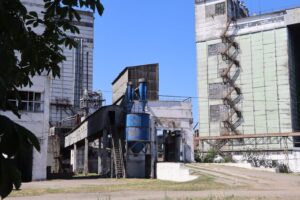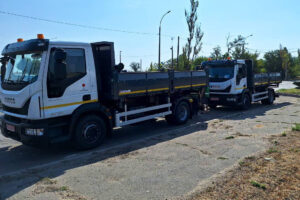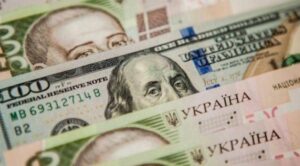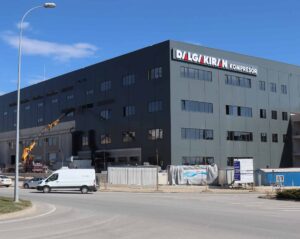
Rivne Azot, a part of Group DF’s nitrogen business, has launched a second production unit at its ammonia shop and increased its mineral fertilizer production capacity, the company’s press service reports.
“Scheduled repairs at Rivne Azot have been completed, and production of basic mineral fertilizers has been increased. The company’s basic ammonia and nitrate shops are 100% operational.
The producer is fully prepared for the autumn increase in demand for mineral fertilizers,” said Mykhailo Zabluda, Chairman of the Board of Rivne Azot.
According to him, as part of the systemic modernization, the plant has installed a distribution control system that reduces production risks and ensures the stability of the company’s operations in the face of power surges and shortages. The company has already implemented a number of energy-efficient solutions aimed at optimizing consumption coefficients, reducing losses of various types of energy and, accordingly, improving fertilizer costs.
According to the production plan, Rivne Azot will produce 1,260 tons of ammonia per day (over 50,000 tons per month), 1,300 tons of nitric acid per day at the nonconcentrated nitric acid shop, and over 1,630 tons of ammonium nitrate per day (over 50,000 tons per month).
Rivne Azot explained that the company managed to load the plant at 100% due to the established import of electricity from abroad and the implementation of projects to launch generating units at the plant, which cover 40% of electricity costs by generating its own. In particular, the company has built and launched special generating equipment (turbine generators) – units that generate electricity from steam utilized from chemical processes.
The design capacity of the generating equipment is about 30 MW.The electricity generated by the turbine generators is used for the company’s own needs.The construction of turbine generators at the enterprise is one of the steps aimed at stabilizing the operation of the equipment in the company’s shops.Ammonia production is the most dependent on stable electricity sources and is considered to be a basic one: the company uses ammonia to make other types of fertilizers, such as ammonium nitrate, UAN, and ammonia water.The commissioning of the generating equipment makes it possible to stabilize the
Ostchem Holding is systematically bringing its ammonium nitrate production facilities to full capacity, but the percentage of load depends on effective demand and import volumes.Cherkasy Azot and Rivne Azot plan to produce 260 thousand tons of nitrogen fertilizers by September 1 this year, and 1 million tons by the end of the autumn season to meet the needs of the Ukrainian market.
Ostchem is a nitrogen holding of Dmitry Firtash’s Group DF that unites the largest mineral fertilizer producers in Ukraine. Since 2011, it has included Rivne Azot and Cherkasy Azot, as well as Severodonetsk Azot and Stirol, which are out of operation and located in the occupied territories.
Cherkasy Azot PJSC (Cherkasy, Ukraine) is one of the largest Ukrainian chemical enterprises with a design capacity of 962.7 thousand tons per year of ammonia, 970 thousand tons per year of ammonium nitrate, 891.6 thousand tons of urea, and 1 million tons per year of UAN.
Rivne Azot is one of the largest Ukrainian chemical companies in Western Ukraine. On April 12, 2024, Group DF and South Korean Hyundai Engineering signed an agreement to build a chemical hub in Rivne. The project envisages the construction of green ammonia and hydrogen plants based on renewable energy sources; new enterprises and production sites for nitrogen fertilizers and chemical derivatives.

On July 19, the State Property Fund (SPF) sold Okhtyrka Bread Products Plant in Sumy region for UAH 49.7 million at an auction, according to the Prozorro.Sale website. According to the report, Golovanivske Grain Receiving Enterprise LLC was the only bidder in the auction and purchased Okhtyrka CPP at the starting price.
The Okhtyrka elevator was part of the system of enterprises of the State Reserve Agency. It is engaged in flour production and employs 128 people. The company has systematically incurred losses: in 2023, they exceeded UAH 12.5 million on revenues of UAH 19 million, and in the first quarter of 2024, they amounted to UAH 4.6 million on revenues of UAH 2.9 million.
The amount of accumulated debt amounted to UAH 32.2 million. The future investor is obliged to pay off wage and budget debts within six months.
Golovanivske Grain Receiving Enterprise LLC was registered in 1998 in Kirovograd region. It specializes in warehousing, wholesale of grain, unprocessed tobacco, seeds and animal feed, dairy products, eggs, edible oils and fats. The authorized capital of the company is UAH 317.1 thousand.
The company was previously owned by Vinnytsia Industrial Company (ViOil Group). In the summer of 2023, the company was re-registered to Karina Nastenko, while the previous director, Valentyn Gorokhovsky, remained in charge.

Japan has handed over new trucks to Kherson’s utility companies, said Roman Mrochko, head of the city’s military administration. “We received the new Japanese equipment under the Grant Agreement for the Emergency Recovery Program between the Japan International Cooperation Agency (JICA) and the government of Ukraine,” Mrochko said in a telegram on Saturday.
He noted that Kherson really needs such equipment and thanked international partners for their help.

Ukraine has reached an agreement in principle with the Eurobond Holders Committee on restructuring, Prime Minister Denys Shmyhal said.
“We are restoring debt sustainability. Today, we have reached agreements in principle with the Eurobond Holders Committee of Ukraine. This is an important step in the debt restructuring process that will save USD 11.4 billion in debt service over the next few years. It will save USD 11.4 billion on its servicing over the next three years and USD 22.75 billion by 2033,” Shmyhal wrote on his Telegram channel.
According to him, this way, Ukraine will be able to free up resources for urgent needs: defense, social protection and recovery.

The National Bank of Ukraine (NBU), after strengthening the official exchange rate of the national currency by 4 kopecks on Thursday, on Friday lowered it by 7 kopecks to a new historical low of 41.4912 UAH/$1.
According to Taras Lisovyi, head of the treasury department of Globus Bank, trading on the interbank foreign exchange market started at 41.50/41.70 UAH/$1, by mid-day the rate strengthened to 41.48/41.51 UAH/$1, and by the end of the trading session it slightly weakened to 41.4950/41.5050 UAH/$1.
“What has been happening in the foreign exchange market over the past two weeks is a logical and objective consequence of rising inflation due to rising electricity tariffs and unprecedented power outages (…),” the banker said.
The volume of deals in the Bloomberg system amounted to $292.42 million. The National Bank set the reference rate at 12:00 on Friday at 41.4944 UAH/$1, compared to 41.4166 UAH/$1 a day earlier. The dollar on the cash market on Friday also rose by about 5 kopecks by mid-afternoon, but at 1 a.m. it fell by the same amount, then rose slightly again: buying – to 41.83 UAH/$1, selling – to $41.93 UAH/$1.
Since the beginning of 2024, the dollar has appreciated by 9.2%, or UAH 3.49, at the official exchange rate, and by 13.4%, or UAH 4.93, since the National Bank switched to managed flexibility on October 3, 2023. Since the beginning of July, the official hryvnia exchange rate has fallen by 2.6%, or UAH 1.04, while in June its decline slowed to 3 kopecks after weakening by 90 kopecks in May.
The NBU attributed the current weakening of the hryvnia to the expansion of net demand over the past two months, driven by increased budget spending, much of which materializes in demand for foreign currency, the May currency liberalization, and a temporary decrease in the supply of foreign currency by the agricultural sector. The NBU explained the latter factor by the exhaustion of last year’s harvest and the fact that, at the request of the Cabinet of Ministers, it extended the deadline for the return of agricultural export earnings to 120 days, which had previously been reduced from 180 to 90 days.
At the same time, the NBU emphasized that there are all the prerequisites for ensuring the stability of the foreign exchange market.
“Soon, foreign currency from the sale of the new harvest will begin to arrive, and the functioning of the sea corridor creates opportunities for active exports of other commodity groups. Also, international aid from our partners will soon become more active: while in the first half of the year Ukraine received about $14 billion, the forecast for the second half of the year is $24 billion,” the NBU said.
In particular, this month the central bank expects to receive $3.9 billion from the United States. “Accordingly, international reserves will again exceed $40 billion,” the central bank said.
As reported, the National Bank’s net sale of dollars in the second week of July decreased to $532.1 million from $630.91 million in the previous week. In June, it amounted to $2.99 billion compared to $3.07 billion in May.

The Turkish company Dalgakiran Kompresör has invested UAH 400 million in the launch of a plant for the production of industrial power equipment in Bilohorodka (Kyiv region), according to a press release from Dalgakiran Compressor Ukraine LLC.
The construction project was started before the start of Russia’s large-scale aggression, and now, thanks to investments from the Turkish side, it has been completed. The investment in the production site and office will create 50 new jobs.
The office and new production facility in Ukraine will contribute to the development of enterprises in all industries, enabling them to continue their business activities, save money and resources,” said Vyacheslav Dinkov, director of Dalgakiran Compressor Ukraine, as quoted by the press service.
According to him, the plans include further development and localization of production, development and supply of new equipment to restore energy and industrial production in Ukraine.
In turn, Dalgakiran Kompresör Chairman of the Board Adnan Dalgakiran noted that scaling up business in Ukraine is a contribution to supporting the country’s economy and energy sector in difficult times. “In the face of a power outage, our equipment can ensure the continuity of business processes and production, enable businesses to continue to operate, pay taxes and provide jobs to Ukrainians,” he said.
“Dalgakiran Compressor Ukraine is a representative office of the Turkish Dalgakiran company specializing in the production and maintenance of generator and compressor equipment, cooling systems and industrial pumps.
The Ukrainian representative office sells the equipment and improves it to meet the needs of national consumers. Azov equipment is manufactured in Turkey, where a full cycle of quality control has been introduced and the company has its own design office.
The company has been operating in Ukraine for 19 years. It has representative offices in 11 cities and more than 70 of its own mobile service teams.